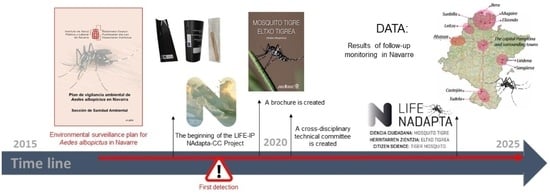The Silent Conquest of Aedes albopictus in Navarre: Unraveling the Unstoppable Advance of the Tiger Mosquito Invasion in Progress
Simple Summary
Abstract
1. Introduction
2. Methodology
- The Bidasoa River area, near Irún, Cinco Villas-Bortziriak, extended to the Señorío de Bértiz;
- The Pamplona region, including the transportation hub, several industrial parks, urban parks, and the vicinity of the municipal cemetery;
- The Tudela area, including industrial parks, the cemetery, a shopping center, and a public park.
2.1. Types of Traps: Ovitraps and Adult Traps
2.2. Environmental Surveillance
2.3. Communication and Dissemination
3. Results and Discussion
4. Conclusions
Author Contributions
Funding
Data Availability Statement
Conflicts of Interest
References
- de Souza, W.M.; Weaver, S.C. Effects of Climate Change and Human Activities on Vector-Borne Diseases. Nat. Rev. Microbiol. 2024, 22, 476–491. [Google Scholar] [CrossRef]
- World Health Organization. The International Atomic Energy Agency Guidance Framework for Testing the Sterile Insect Technique as a Vector Control Tool Against Aedes-Borne Diseases; World Health Organization: Geneva, Switzerland, 2020; ISBN 978-92-4-000237-1. [Google Scholar]
- Alarcón-Elbal, P.M.; Suárez-Balseiro, C.; De Souza, C.; Soriano-López, A.; Riggio-Olivares, G. History of Research on Aedes albopictus (Diptera: Culicidae) in Europe: Approaching the World’s Most Invasive Mosquito Species from a Bibliometric Perspective. Parasitol. Res. 2024, 123, 130. [Google Scholar] [CrossRef]
- Real Decreto 630/2013, de 2 de Agosto, por el que se Regula el Catálogo Español de Especies Exóticas Invasoras. BOE. 2013 Aug 3;185:56764-56786. Gobierno de España. BOE-A-2013-8565. Available online: https://www.boe.es/eli/es/rd/2013/08/02/630 (accessed on 2 July 2025).
- Ley 42/2007, de 13 de Diciembre, del Patrimonio Natural y de la Biodiversidad. BOE. 2007 Dec 14;299. Gobierno de España. BOE-A-2007-21490. Available online: https://www.boe.es/eli/es/l/2007/12/13/42/con (accessed on 2 July 2025).
- Müller, P.; Engeler, L.; Vavassori, L.; Suter, T.; Guidi, V.; Gschwind, M.; Tonolla, M.; Flacio, E. Surveillance of Invasive Aedes Mosquitoes along Swiss Traffic Axes Reveals Different Dispersal Modes for Aedes albopictus and Ae. japonicus. PLoS Neglected Trop. Dis. 2020, 14, e0008705. [Google Scholar] [CrossRef]
- Bonizzoni, M.; Gasperi, G.; Chen, X.; James, A.A. The Invasive Mosquito Species Aedes albopictus: Current Knowledge and Future Perspectives. Trends Parasitol. 2013, 29, 460–468. [Google Scholar] [CrossRef] [PubMed]
- Gobierno de Navarra. Plan de Vigilancia Ambiental de Aedes albopictus en Navarra; Instituto de Salud Pública y Laboral de Navarra: Pamplona, Spain, 2016. [Google Scholar]
- Benedict, M.Q.; Levine, R.S.; Hawley, W.A.; Lounibos, L.P. Spread of The Tiger: Global Risk of Invasion by The Mosquito Aedes albopictus. Vector-Borne Zoonotic Dis. 2007, 7, 76–85. [Google Scholar] [CrossRef]
- Aranda, C.; Eritja, R.; Roiz, D. First Record and Establishment of the Mosquito Aedes albopictus in Spain. Med. Vet. Entomol. 2006, 20, 150–152. [Google Scholar] [CrossRef]
- Collantes, F.; Delacour, S.; Alarcón-Elbal, P.M.; Ruiz-Arrondo, I.; Delgado, J.A.; Torrell-Sorio, A.; Bengoa, M.; Eritja, R.; Miranda, M.Á.; Molina, R.; et al. Review of Ten-Years Presence of Aedes albopictus in Spain 2004–2014: Known Distribution and Public Health Concerns. Parasites Vectors 2015, 8, 655. [Google Scholar] [CrossRef] [PubMed]
- Miqueleiz, E.; González, M.Á.; Domench, M.; Navarro, P.; Iniesta, I.; Aguilar, A.; Agudo, B.; Ferrer, T.; Álvarez, N.; Ardanaz, E.; et al. El cambio climático constituye una emergencia de salud global. Panacea 2024, 139, 38–45. [Google Scholar] [CrossRef]
- González-Moreno, M.Á. Contextualización al cambio climático en Navarra. In Proceedings of the Jornada Ntroducción a La Adaptación Al Cambio Climático en el Sector Agroforestal, Pamplona, Spain, 23 March 2023. [Google Scholar]
- Goiri, F.; González, M.A.; Goikolea, J.; Oribe, M.; Castro, V.d.; Delacour, S.; Lucientes, J.; Ortega-Araiztegi, I.; Barandika, J.F.; García-Pérez, A.L. Progressive Invasion of Aedes albopictus in Northern Spain in The Period 2013–2018 and A Possible Association with the Increase in Insect Bites. Int. J. Environ. Res. Public Health 2020, 17, 1678. [Google Scholar] [CrossRef]
- Bravo-Barriga, D.; Gouveia Almeida, A.P.; Parreira, R.; Jiménez-Vidal, D.; Pérez-Martín, J.E.; Martín-Cuervo, M.; Frontera, E. First detections of Aedes albopictus (tiger mosquito) in the region of Extremadura, west of Spain. Gac. Sanit. 2019, 33, 299–300. [Google Scholar] [CrossRef]
- Collantes, F.; Méndez, M.J.; Soto-Castejón, C.; Muelas, E.M. Consolidation of Aedes albopictus Surveillance Program in the Autonomous Community of the Region of Murcia, Spain. Int. J. Environ. Res. Public Health 2020, 17, 4173. [Google Scholar] [CrossRef] [PubMed]
- Bellini, R.; Michaelakis, A.; Petrić, D.; Schaffner, F.; Alten, B.; Angelini, P.; Aranda, C.; Becker, N.; Carrieri, M.; Di Luca, M.; et al. Practical Management Plan for Invasive Mosquito Species in Europe: I. Asian Tiger Mosquito (Aedes albopictus). Travel Med. Infect. Dis. 2020, 35, 101691. [Google Scholar] [CrossRef]
- European Centre for Disease Prevention and Control Guidelines for the Surveillance of Invasive Mosquitoes in Europe; ECDC: Stockholm, Sweden, 2012; ISBN 978-92-9193-378-5.
- Barrera, R. New Tools for Aedes Control: Mass Trapping. Curr. Opin. Insect Sci. 2022, 52, 100942. [Google Scholar] [CrossRef]
- Johnson, B.J.; Ritchie, S.A.; Fonseca, D.M. The State of the Art of Lethal Oviposition Trap-Based Mass Interventions for Arboviral Control. Insects 2017, 8, 5. [Google Scholar] [CrossRef] [PubMed]
- Garrido, M.; Veiga, J.; Garrigós, M.; Morales-Yuste, M.; Recuero-Gil, J.; Martínez-de la Puente, J. Aedes albopictus in a Recently Invaded Area in Spain: Effects of Trap Type, Locality, and Season on Mosquito Captures. Sci. Rep. 2024, 14, 2131. [Google Scholar] [CrossRef] [PubMed]
- Anicic, N.; Steigmiller, K.; Renaux, C.; Ravasi, D.; Tanadini, M.; Flacio, E. Optical Recognition of the Eggs of Four Aedine Mosquito Species (Aedes albopictus, Aedes geniculatus, Aedes japonicus, and Aedes koreicus). PLoS ONE 2023, 18, e0293568. [Google Scholar] [CrossRef]
- Hill, L.A.; Davis, J.B.; Hapgood, G.; Whelan, P.I.; Smith, G.A.; Ritchie, S.A.; Cooper, R.D.; van den Hurk, A.F. Rapid Identification of Aedes albopictus, Aedes scutellaris, and Aedes aegypti Life Stages Using Real-Time Polymerase Chain Reaction Assays. Am. J. Trop. Med. Hyg. 2008, 79, 866–875. [Google Scholar] [CrossRef]
- Lokímica Laboratorios. Análisis de la Vulnerabilidad del Territorio y Adaptación del Plan de Vigilancia Entomológica Actual al Mismo; Instituto de Salud Pública y Laboral de Navarra: Pamplona, Spain, 2019; p. 41. [Google Scholar]
- Bellver-Arnau, J.; Blanco-Sierra, L.; Escartin, S.; Mariani, S.; Bartumeus, F. Climate-Responsive Vector Control Strategies for Aedes albopictus. Parasites Vectors 2025, 18, 168. [Google Scholar] [CrossRef]
- LIFE-IP NAdapta-CC Navarra Adapts to Climate Change. Monitoring Indicators Portal. Available online: https://monitoring-en.lifenadapta.eu/ (accessed on 2 July 2025).
- Swan, T.; Russell, T.L.; Staunton, K.M.; Field, M.A.; Ritchie, S.A.; Burkot, T.R. A Literature Review of Dispersal Pathways of Aedes albopictus across Different Spatial Scales: Implications for Vector Surveillance. Parasites Vectors 2022, 15, 303. [Google Scholar] [CrossRef]
- AEMET. Informes Sobre el Estado del Clima de España; Gobierno de España: Madrid, Spain, 2024. [Google Scholar] [CrossRef]
- Lührsen, D.S.; Zavitsanou, E.; Cerecedo-Iglesias, C.; Pardo-Araujo, M.; Palmer, J.R.B.; Bartumeus, F.; Montalvo, T.; Michaelakis, A.; Lowe, R. Adult Aedes albopictus in Winter: Implications for Mosquito Surveillance in Southern Europe. Lancet Planet. Health 2023, 7, e729–e731. [Google Scholar] [CrossRef] [PubMed]
- Gobierno de Navarra Epidemiología. Boletines de Salud Pública. Available online: https://www.navarra.es/home_es/Gobierno+de+Navarra/Organigrama/Los+departamentos/Salud/Organigrama/Estructura+Organica/Instituto+Navarro+de+Salud+Publica/Publicaciones/Publicaciones+profesionales/Epidemiologia/Boletin+ISP.htm (accessed on 2 July 2025).
- González-Moreno, M.Á. El Trabajo en Cambio Climatco en Navarra Proyecto LIFE-IP NAdapta-CC. In Proceedings of the III Foro Cambio Climático y Salud Global, Pamplona, Spain, 21 May 2024. [Google Scholar]
- Miqueleiz Autor, E. Adaptación en Navarra al cambio climático en salud. In Proceedings of the III Foro Cambio Climático y Salud Global, Pamplona, Spain, 21 May 2024. [Google Scholar]
- González-Moreno, M.Á. El proyecto LIFE-IP NAdapta-CC. In Proceedings of the Jornada del Programa de Intercambio de Profesionales Sanitarios HOPE 2023. Clima y Medio Ambiente: Desafíos Para Hospitales y Servicios de Salud, Pamplona, Spain, 16 May 2023. [Google Scholar]
- Miqueleiz Autor, E.; Domench Guembe, M.; Iniesta Martínez, I.; Navarro Muñoa, P.; Agudo García, B.; Aguilar Bailo, A.; Ardanaz Aicua, E.; Laborda Santesteban, M. Cambio Climático y Salud. Experiencia de Adaptación En Navarra, Proyecto LIFE NAdapta. In Proceedings of the XL Reunión Anual de la Sociedad Española de Epidemiología (SEE) y XVII Congresso da Associação Portuguesa de Epidemiología (APE), Donostia, Spain, 31 August–2 September 2022; Sociedad Española de Salud Pública y Administración Sanitaria: Barcelona, Spain, 2022; Volume 36, p. 376. [Google Scholar]
- Bueno Marí, R.; Gil Arques, A.; Ferrer Gimeno, T.; Agudo García, B.; Jiménez Vidal, D.; García Howlett, M. Theorical Model of Aedes albopictus Entrance and Establishment in Spain Integrated in Eu Climate Projects: The Case of Navarra. In Proceedings of the Tenth International Conference on Urban Pests, Barcelona, Spain, 27–29 June 2022; ICUP: Sant Adrià de Besòs, Spain, 2022. [Google Scholar]
- Miqueleiz Autor, E. ¿Cómo afecta el cambio climático a la salud? Situación en Navarra. In Proceedings of the OPEN DAYS SALUD: Vigilancia y Seguimiento del Mosquito Tigre en Navarra, Bertiz, Spain, 20 June 2024. [Google Scholar]
- González-Moreno, M.Á. Cambio climático en Navarra. El proyecto LIFE-IP NAdapta-CC. In Proceedings of the OPEN DAYS SALUD: Vigilancia y Seguimiento del Mosquito Tigre en Navarra, Bertiz, Spain, 20 June 2024. [Google Scholar]
- Domench Guembe, M. Mosquito tigre: ¿Qué podemos hacer para combatirlo? In Proceedings of the OPEN DAYS SALUD: Vigilancia y Seguimiento del Mosquito Tigre en Navarra, Bertiz, Spain, 20 June 2024. [Google Scholar]
- Ferrer Gimeno, T. Vectores y salud. Vigilancia y seguimiento del mosquito tigre en CFN. In Proceedings of the OPEN DAYS SALUD: Vigilancia y Seguimiento del Mosquito Tigre en Navarra, Bertiz, Spain, 20 June 2024. [Google Scholar]
- San Miguel Ibáñez, E. Identificación del mosquito tigre en el laboratorio. In Proceedings of the OPEN DAYS SALUD: Vigilancia y Seguimiento del Mosquito Tigre en Navarra, Bertiz, Spain, 6 June 2024. [Google Scholar]
- Mosquito Alert Ciencia Ciudadana para Investigar y Controlar Mosquitos Transmisores de Enfermedades. Available online: https://www.mosquitoalert.com/ (accessed on 3 July 2025).
- González-Moreno, M.Á.; Domench-Guembe, M.; Ferrer-Gimeno, T.; Bautista Sanz, I.; Almarcegui Artieda, I.; Miqueleiz-Autor, E.; Dozzi, J. Citizen Science Experiences against the Tiger Mosquito in High Schools of Navarre (Spain). In Proceedings of the 3rd International One Health Conference Mediterranean: Humanity’s Crossroads for Climate, Child, and Maternal Health, Athens, Greece, 15–17 October 2024. [Google Scholar]
- Observatorio de la Ciencia Ciudadana en España «Patrulla Tigre»–Mosquito Tigre & LIFE-IP NAdapta-CC. Available online: https://ciencia-ciudadana.es/proyecto-cc/patrulla-tigre-mosquito-tigre-life-ip-nadapta-cc/ (accessed on 2 April 2025).
- Miqueleiz, E.; González-Moreno, M.Á.; Iniesta, I.; Aguilar, A.; Ferrer, T. Buenas prácticas en adaptación al cambio climático en salud en Navarra. Rev. Salud Ambient. 2025, 25, 27–31. [Google Scholar]
- González-Moreno, M.Á.; Miqueleiz Autor, E.; Ferrer Gimeno, T.; Domench Guembe, M. El riesgo de nuevos vectores: El caso del mosquito tigre. Navar. Más Médica 2025, 1, 38–39. [Google Scholar] [CrossRef]
- del Burgo, A.S.; Leiza, N.M. Vectores de enfermedades emergentes en ganadería. Navar. Agrar. 2023, 255, 12–16. [Google Scholar]
- Gobierno de Navarra-Mosquito Tigre-Eltxo Tigrea (Aedes albopictus). Available online: https://www.navarra.es/NR/rdonlyres/A3FC389F-266D-41A8-9589-11DF447325CB/492989/ParawebBilingue.pdf (accessed on 3 July 2025).
- LIFE-IP NAdapta-CC|El Mosquito Tigre en Navarra. Available online: https://www.youtube.com/watch?v=7EzcjqwTE2k (accessed on 3 July 2025).
- LIFE-IP NAdapta-CC|Eltxo Tigrea Nafarroan. Available online: https://www.youtube.com/watch?v=D-_r6t5uu2Q (accessed on 3 July 2025).
- Blanco-Sierra, L.; Bellver-Arnau, J.; Escartin, S.; Mariani, S.; Bartumeus, F. Human–Environment Interactions Shape Mosquito Seasonal Population Dynamics. Insects 2024, 15, 527. [Google Scholar] [CrossRef] [PubMed]
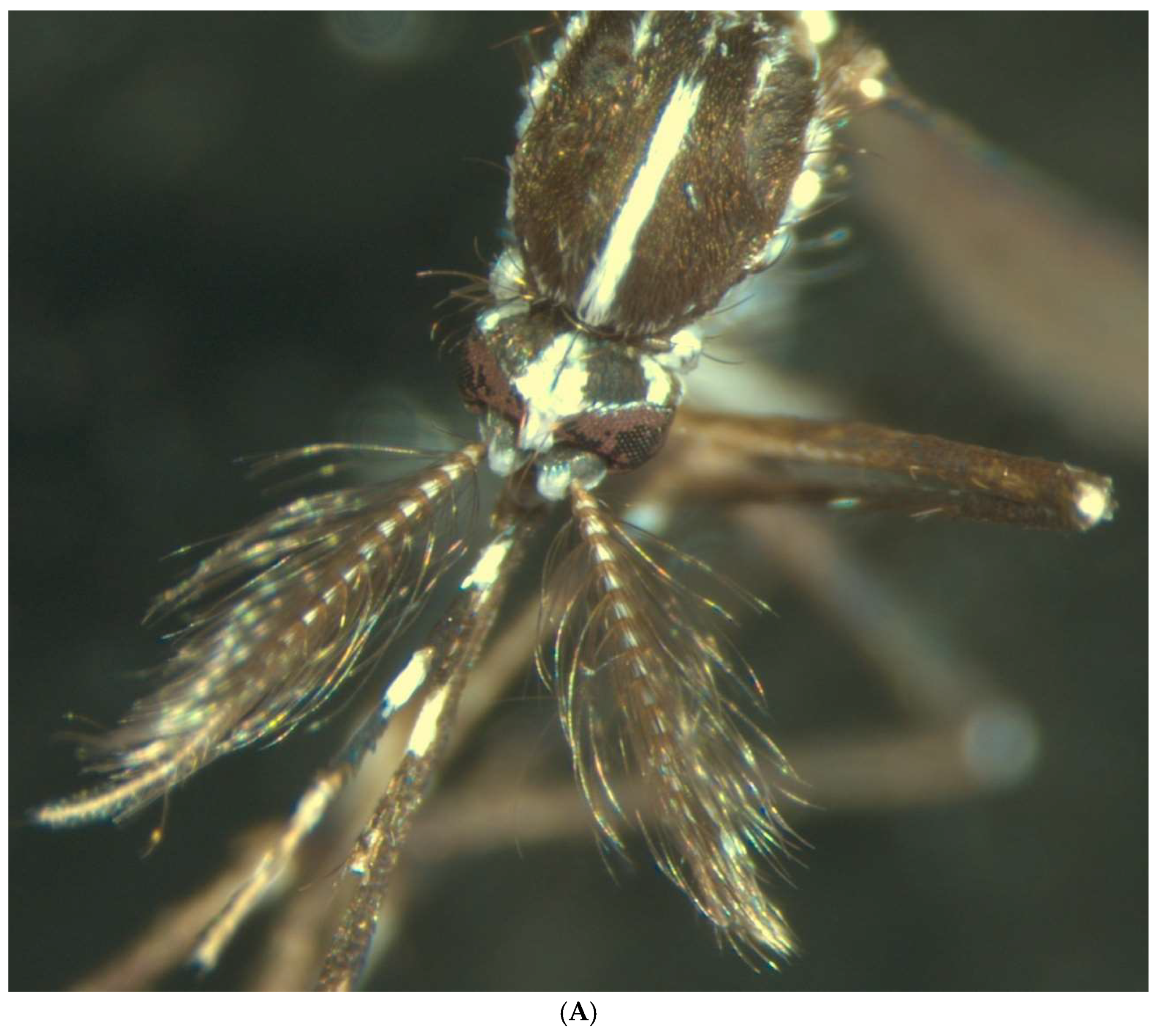

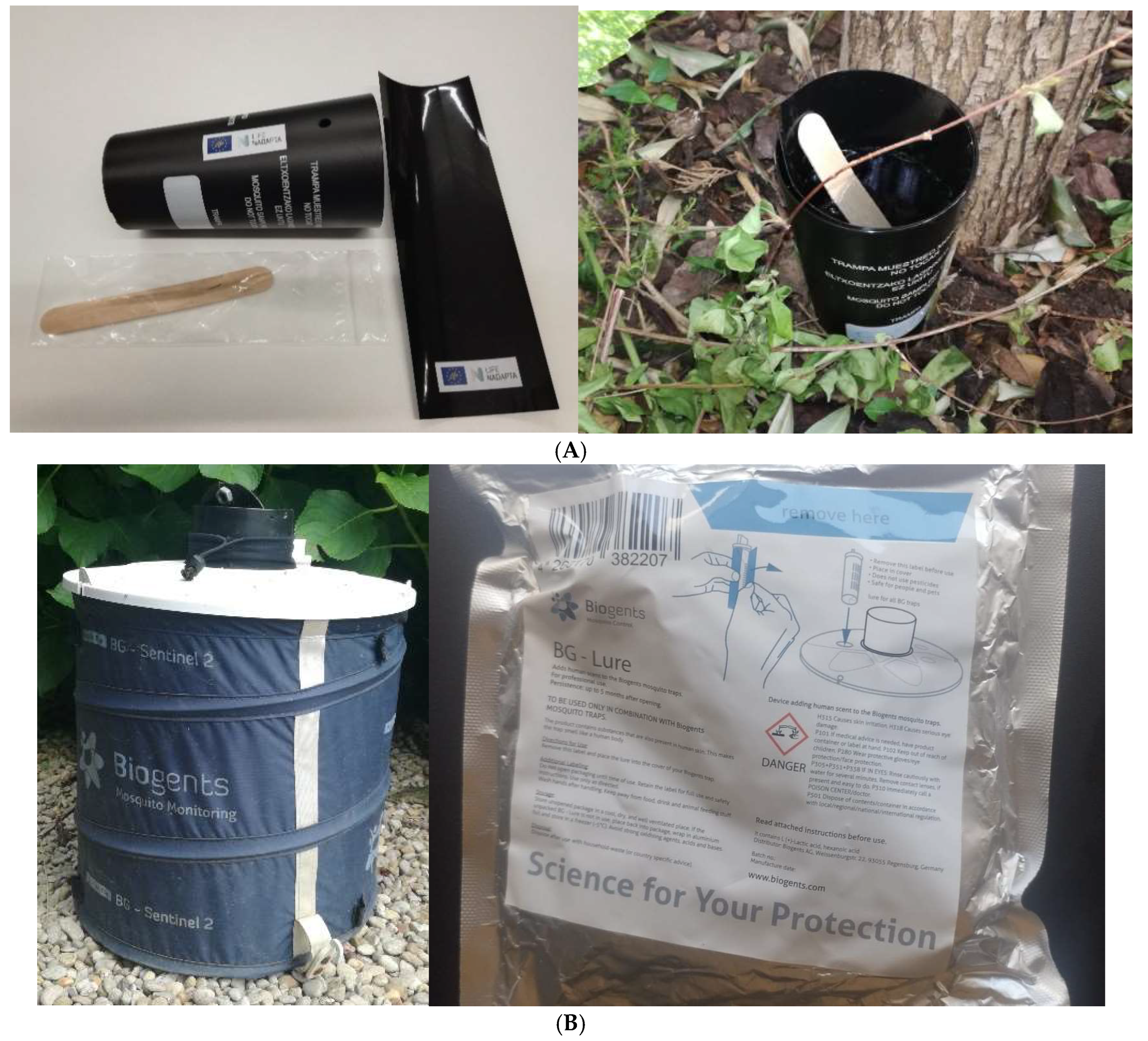

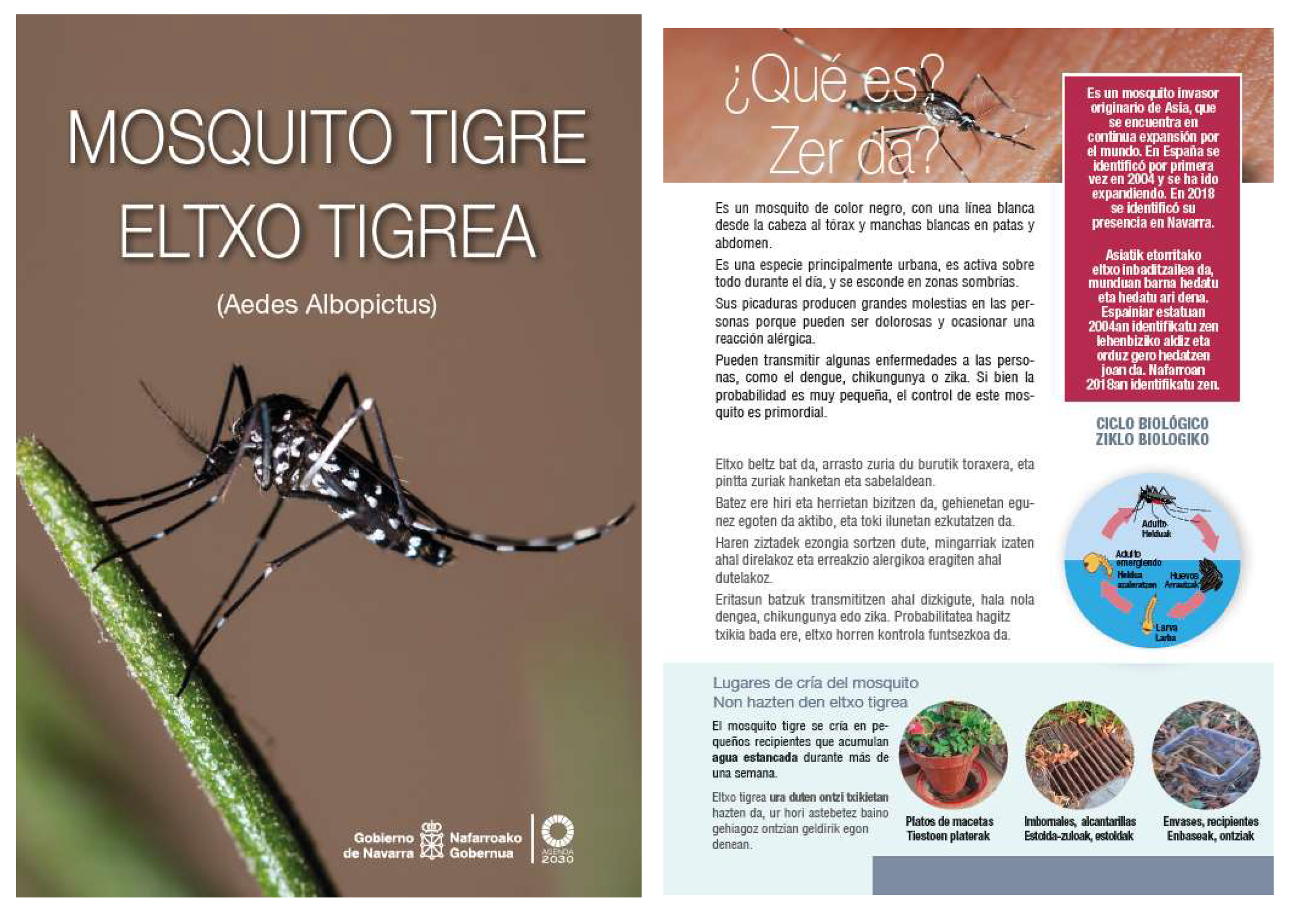
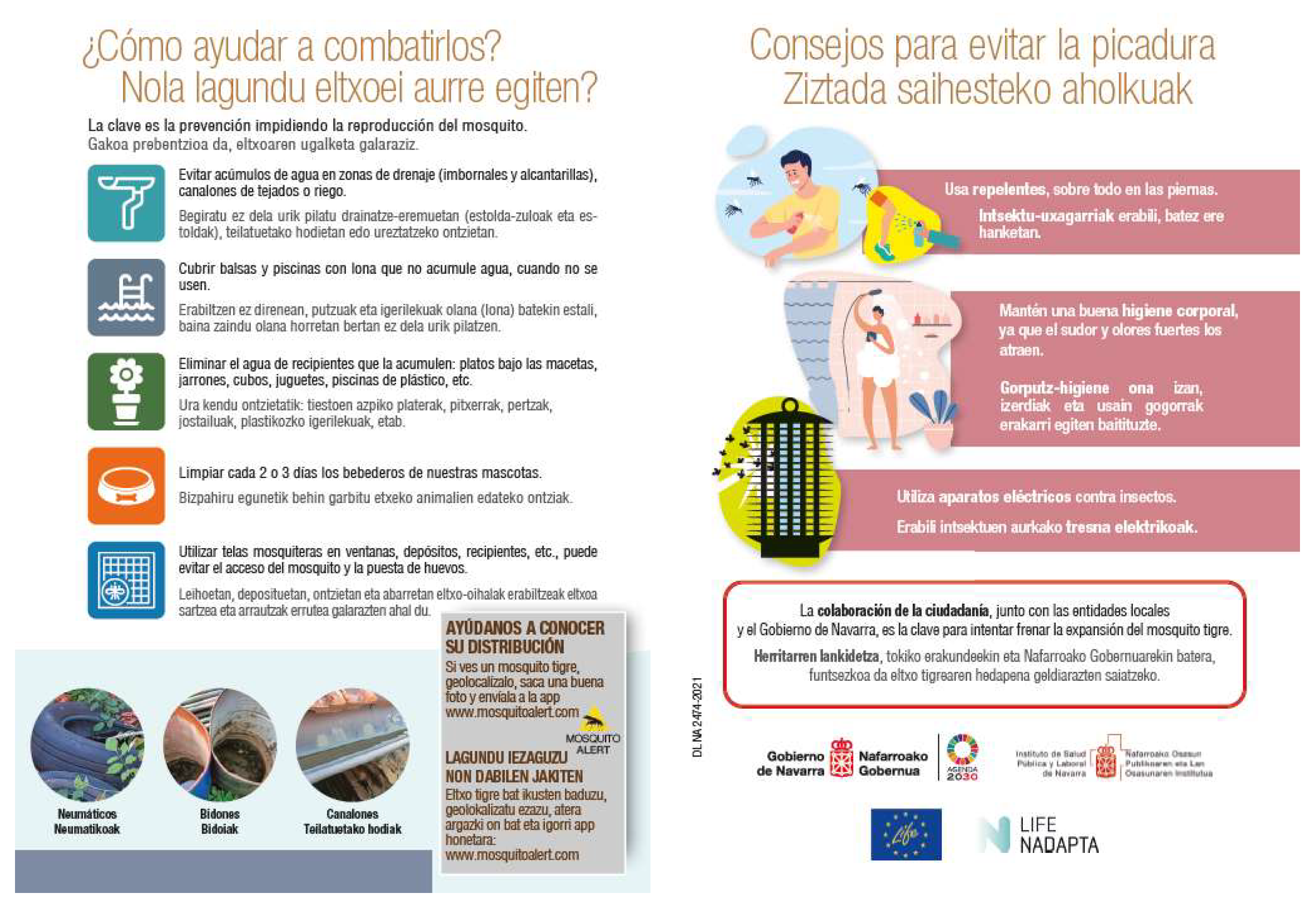
| Year | Surveillance Points | Samples Collected | Positive Samples | Municipalities Affected | Entomological Blockages Performed | ||
|---|---|---|---|---|---|---|---|
| Adults | Ovitraps | Eggs | Adults + Larvae | ||||
| 2016 | 0 | 47 | 477 | 0 | 0 | 0 | 0 |
| 2017 | 0 | 66 | 856 | 0 | 0 | 0 | 0 |
| 2018 | 0 | 75 | 817 | 1 | 0 | 1 | 0 |
| 2019 | 2 | 53 | 1359 | 1 | 0 | 1 | 1 |
| 2020 | 2 | 62 | 1654 | 28 | 1 | 2 | 2 |
| 2021 | 2 | 62 | 1617 | 12 | 5 | 1 | 2 |
| 2022 | 2 | 63 | 1745 | 46 | 187 | 4 | 2 |
| 2023 | 2 | 67 | 1817 | 34 | 1078 | 11 | 2 |
| 2024 | 2 | 68 + 23 * | 1736 | 29 | 783 | 18 | 1 |
Disclaimer/Publisher’s Note: The statements, opinions and data contained in all publications are solely those of the individual author(s) and contributor(s) and not of MDPI and/or the editor(s). MDPI and/or the editor(s) disclaim responsibility for any injury to people or property resulting from any ideas, methods, instructions or products referred to in the content. |
© 2025 by the authors. Licensee MDPI, Basel, Switzerland. This article is an open access article distributed under the terms and conditions of the Creative Commons Attribution (CC BY) license (https://creativecommons.org/licenses/by/4.0/).
Share and Cite
González-Moreno, M.Á.; Miqueleiz-Autor, E.; Oroz-Santamaría, I.; Domench-Guembe, M.; Poveda-Urkixo, I. The Silent Conquest of Aedes albopictus in Navarre: Unraveling the Unstoppable Advance of the Tiger Mosquito Invasion in Progress. Insects 2025, 16, 852. https://doi.org/10.3390/insects16080852
González-Moreno MÁ, Miqueleiz-Autor E, Oroz-Santamaría I, Domench-Guembe M, Poveda-Urkixo I. The Silent Conquest of Aedes albopictus in Navarre: Unraveling the Unstoppable Advance of the Tiger Mosquito Invasion in Progress. Insects. 2025; 16(8):852. https://doi.org/10.3390/insects16080852
Chicago/Turabian StyleGonzález-Moreno, Miguel Ángel, Estrella Miqueleiz-Autor, Itsaso Oroz-Santamaría, Miguel Domench-Guembe, and Irati Poveda-Urkixo. 2025. "The Silent Conquest of Aedes albopictus in Navarre: Unraveling the Unstoppable Advance of the Tiger Mosquito Invasion in Progress" Insects 16, no. 8: 852. https://doi.org/10.3390/insects16080852
APA StyleGonzález-Moreno, M. Á., Miqueleiz-Autor, E., Oroz-Santamaría, I., Domench-Guembe, M., & Poveda-Urkixo, I. (2025). The Silent Conquest of Aedes albopictus in Navarre: Unraveling the Unstoppable Advance of the Tiger Mosquito Invasion in Progress. Insects, 16(8), 852. https://doi.org/10.3390/insects16080852





